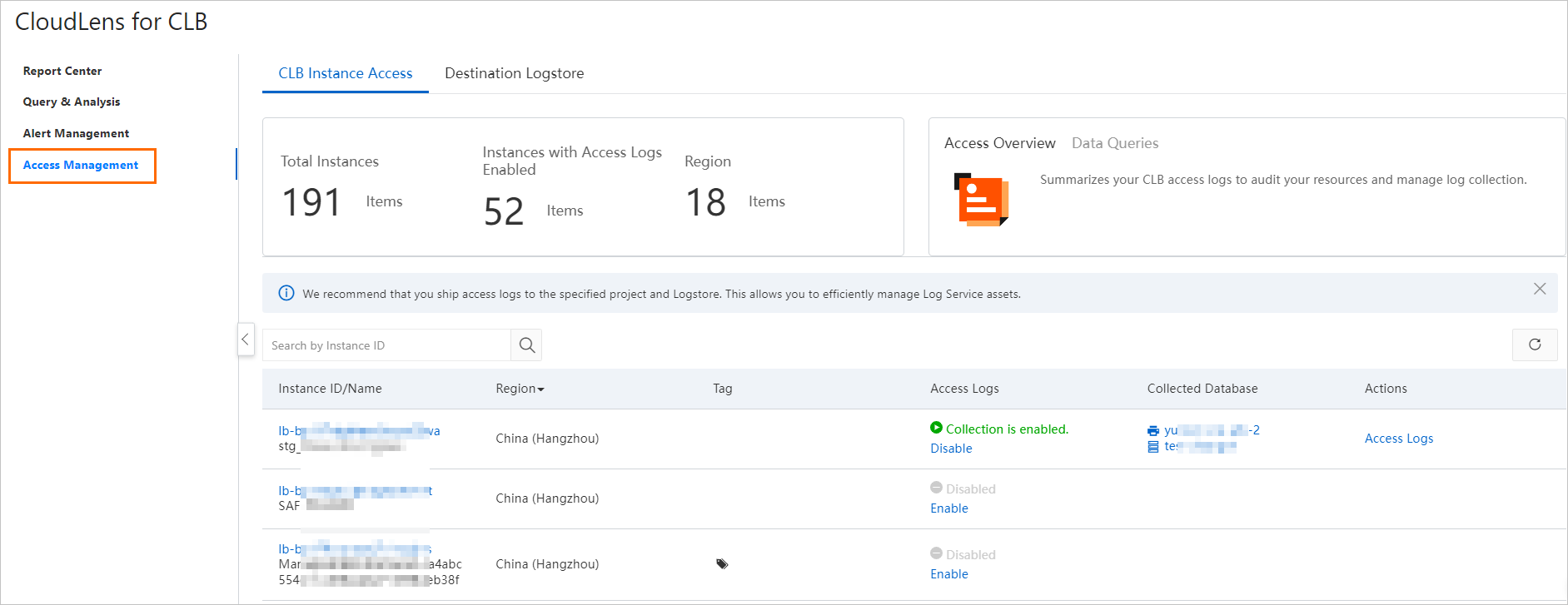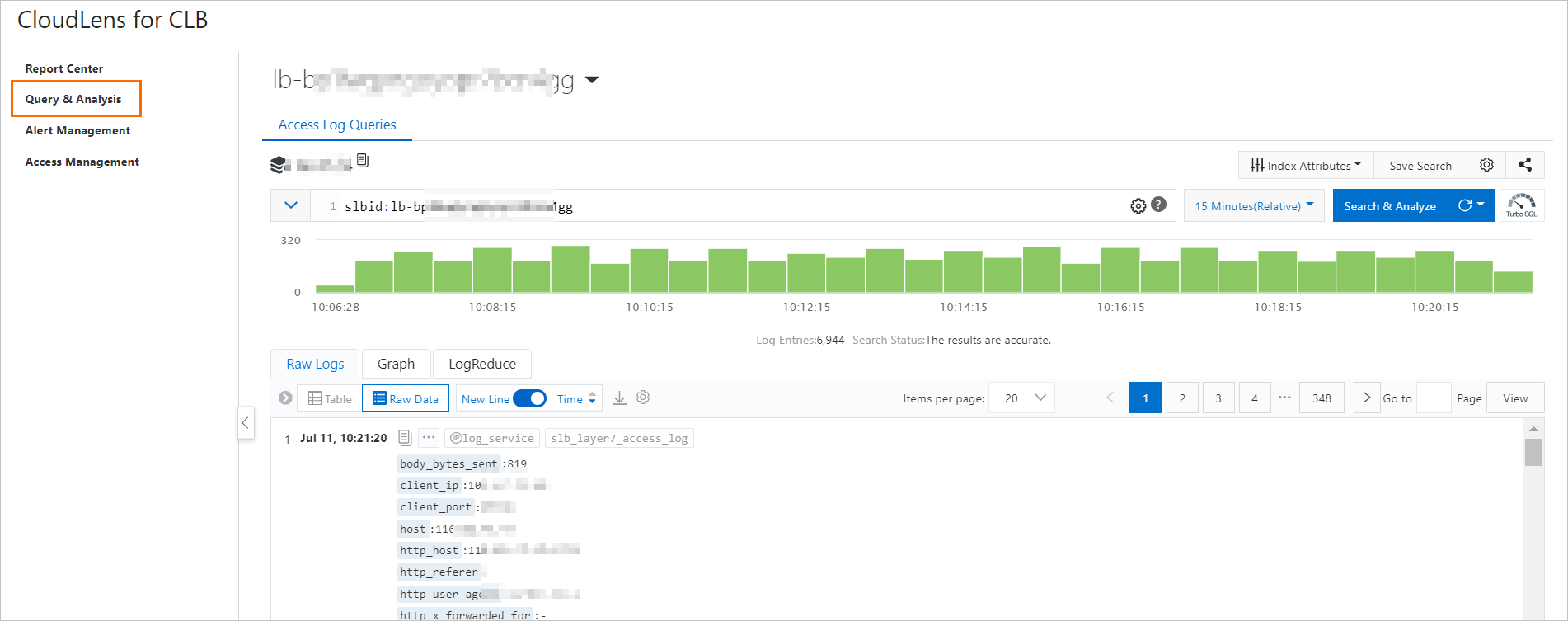Simple Log Service and Alibaba Cloud Server Load Balancer (SLB) jointly launch the CloudLens for CLB application. You can use the application to analyze Classic Load Balancer (CLB) access logs, Cloud Config logs, and CloudMonitor events, analyze metrics in seconds, and generate alerts in real time. The application also provides AIOps-based automated anomaly detection. The CloudLens for CLB application allows you to analyze the behavior, geographical distribution, request success rate, and response latency of clients. This topic describes the features, benefits, assets, billing, and limits of the CloudLens for CLB application.
Features
The CloudLens for CLB application automatically aggregates real-time access logs and provides features such as intelligent inspection and real-time alerting.

The application allows you to manage all CLB instances within your Alibaba Cloud account in a centralized manner.

The application allows you to enable the log collection feature for instance logs and global logs with a few clicks and manage the log collection status in a centralized manner. Instance logs are access logs, and global logs consist of Cloud Config logs and CloudMonitor events. For more information, see Enable the data collection feature.
Access logs record detailed information about all requests that are sent to CLB instances. The information includes the time when the request is initiated, client IP address, latency, request path, and response from the server.
Cloud Config logs consist of change logs and resource non-compliance logs of Cloud Config.
CloudMonitor events are the events that are related to SLB certificate expiration.

The application allows you to store, query, and analyze CLB access logs in real time.

The application provides various reports, including Monitoring Center and Instance Inspection. You can subscribe to these reports and configure settings to send the reports by using emails or DingTalk group messages.

The application supports custom alert settings and can send alert notifications by using the following methods: Message Center, text messages, emails, voice calls, DingTalk, and custom webhooks.

The application extracts various metrics in real time based on raw access logs. The metrics include page views (PVs), request success rates, average latency, P50 latency, P99 latency, and inbound and outbound traffic. The application can extract metrics from one or more of the following dimensions: slbid, host, method, and status.
The application provides the intelligent inspection feature and supports global inspection and slbid-based inspection. You can label anomalies in reports.
Benefits
Easy-to-use: You can enable the application with a few clicks and use centralized storage for the application. You do not need to focus on the collection, storage, computing, and visualization of logs. This allows developers and O&M personnel to focus on business development and technical research without the need to worry about tedious and time-consuming log processing.
Capable of processing large amounts of data: The number of CLB access logs increases with the number of PVs for CLB instances. This way, a large number of access logs are accumulated. When you process the large number of access logs, you must balance performance and costs. In this case, you can use the CloudLens for CLB application, which can improve query performance. The application supports custom settings for the pre-aggregation feature and can use the feature to calculate and aggregate metrics in real time. After the aggregation, the data volume significantly reduces.
Real-time: Real-time data is required in scenarios such as DevOps, monitoring, and alerting. The application can analyze and process real-time logs in seconds by integrating Alibaba Cloud SLB with the big data computing capabilities of Simple Log Service.
Flexible: You can enable or disable the access log management feature based on the specifications of your CLB instances. You can also specify a custom retention period for logs. The storage capacity of a Logstore can be dynamically scaled to meet service requirements.
Intelligent: The application automatically inspects CLB metrics to identify and locate errors in an efficient and accurate manner based on the AIOps algorithms that are developed by Alibaba DAMO Academy.
Assets
You can view the assets of the CloudLens for CLB application in the project that you specify. The following assets are included:
Logstore
The Logstore that is used to store CLB access logs. You can use a custom Logstore.
The Logstore that is used to store Cloud Config logs. You can use a custom Logstore.
The Logstore that is used to store CloudMonitor events. You can use a custom Logstore.
The Logstore that is used to store inspection results. After you enable the log collection feature for access logs, Simple Log Service automatically generates a dedicated Logstore named Logstore for access logs-metrics-result.
WarningDo not delete the preceding Logstores. If you delete the preceding Logstores, related logs cannot be collected to Simple Log Service.
Do not delete the indexes of specific fields in the Logstore that is used to store CLB access logs. If you delete the indexes, metric conversion fails.
Metricstore
The Metricstore is used to store the metrics that are generated after raw metrics are aggregated. After you enable the log collection feature for access logs, Simple Log Service automatically generates a dedicated Metricstore named Logstore for access logs-metrics.
NoteThe Metricstore stores the metrics that are generated after raw metrics are aggregated. The data volume significantly reduces after aggregation, and you can store aggregated metrics for a long period of time.
Aggregation rules
Rule name
Time granularity
Dimension
New metric
total
10 seconds
total
pv
body_bytes_sent_avg
body_bytes_sent_sum
request_length_avg
request_length_sum
upstream_response_time_avg
upstream_response_time_p50
upstream_response_time_p90
upstream_response_time_p99
request_time_avg
request_time_p50
request_time_p90
request_time_p99
slbid
10 seconds
slbid
pv:slb
body_bytes_sent_avg:slb
body_bytes_sent_sum:slb
request_length_avg:slb
request_length_sum:slb
upstream_response_time_avg:slb
upstream_response_time_p50:slb
upstream_response_time_p90:slb
upstream_response_time_p99:slb
request_time_avg:slb
request_time_p50:slb
request_time_p90:slb
request_time_p99:slb
slbid_host_status
10 seconds
slbid+host+status
pv:slbid:host:status
body_bytes_sent_avg:slbid:host:status
body_bytes_sent_sum:slbid:host:status
request_length_avg:slbid:host:status
request_length_sum:slbid:host:status
upstream_response_time_avg:slbid:host:status
upstream_response_time_p50:slbid:host:status
upstream_response_time_p90:slbid:host:status
upstream_response_time_p99:slbid:host:status
request_time_avg:slbid:host:status
request_time_p50:slbid:host:status
request_time_p90:slbid:host:status
request_time_p99:slbid:host:status
slbid+host+status+request_method+upstream_status+url
10 seconds
slbid+host+status+request_method+upstream_status+url
pv:slbid:host:status:method:upstream_status
body_bytes_sent_avg:slbid:host:status:method:upstream_status
body_bytes_sent_sum:slbid:host:status:method:upstream_status
request_length_avg:slbid:host:status:method:upstream_status
request_length_sum:slbid:host:status:method:upstream_status
upstream_response_time_avg:slbid:host:status:method:upstream_status
upstream_response_time_p50:slbid:host:status:method:upstream_status
upstream_response_time_p90:slbid:host:status:method:upstream_status
upstream_response_time_p99:slbid:host:status:method:upstream_status
request_time_avg:slbid:host:status:method:upstream_status
request_time_p50:slbid:host:status:method:upstream_status
request_time_p90:slbid:host:status:method:upstream_status
request_time_p99:slbid:host:status:method:upstream_status
Inspection rules
Rule name
Status
Algorithm
Metric
slb-patrol-total
This rule is enabled by default.
Time2Graph
pv
body_bytes_sent_avg
body_bytes_sent_sum
request_length_avg
request_length_sum
upstream_response_time_avg
upstream_response_time_p50
upstream_response_time_p90
upstream_response_time_p99
request_time_avg
request_time_p50
request_time_p90
request_time_p99
slb-patrol-slb
This rule is enabled by default.
Time2Graph
pv:slb
body_bytes_sent_avg:slb
body_bytes_sent_sum:slb
request_length_avg:slb
request_length_sum:slb
upstream_response_time_avg:slb
upstream_response_time_p50:slb
upstream_response_time_p90:slb
upstream_response_time_p99:slb
request_time_avg:slb
request_time_p50:slb
request_time_p90:slb
request_time_p99:slb
slb-patrol-slbid_host_status
This rule is disabled by default.
Time2Graph
pv:slbid:host:status
body_bytes_sent_avg:slbid:host:status
body_bytes_sent_sum:slbid:host:status
request_length_avg:slbid:host:status
request_length_sum:slbid:host:status
upstream_response_time_avg:slbid:host:status
upstream_response_time_p50:slbid:host:status
upstream_response_time_p90:slbid:host:status
upstream_response_time_p99:slbid:host:status
request_time_avg:slbid:host:status
request_time_p50:slbid:host:status
request_time_p90:slbid:host:status
request_time_p99:slbid:host:status
slb-patrol-slbid_host_status_request_method_upstream_status
This rule is disabled by default.
Time2Graph
pv:slbid:host:status:method:upstream_status
body_bytes_sent_avg:slbid:host:status:method:upstream_status
body_bytes_sent_sum:slbid:host:status:method:upstream_status
request_length_avg:slbid:host:status:method:upstream_status
request_length_sum:slbid:host:status:method:upstream_status
upstream_response_time_avg:slbid:host:status:method:upstream_status
upstream_response_time_p50:slbid:host:status:method:upstream_status
upstream_response_time_p90:slbid:host:status:method:upstream_status
upstream_response_time_p99:slbid:host:status:method:upstream_status
request_time_avg:slbid:host:status:method:upstream_status
request_time_p50:slbid:host:status:method:upstream_status
request_time_p90:slbid:host:status:method:upstream_status
request_time_p99:slbid:host:status:method:upstream_status
Dedicated dashboards
Dashboard
Associated Logstore or Metricstore
Description
Monitoring Overview
Logstore for access logs-metrics
Displays the overall information about the metrics of CLB instances. The metrics include Core Indicators, Error Code, Traffic, Exception Event, PVs, and Access Success Rate.
Monitoring Center
Logstore for access logs-metrics
Logstore for access logs
Displays the real-time monitoring data of CLB instances. The data includes PVs, Request Success Rate, Average Latency, Requests with Status Code 4xx, Status Distribution, Traffic, P50 Latency, P90 Latency, P99 Latency, Hosts with Most Requests, Hosts with Highest Latency, Hosts with Highest Failure Rate, URLs with Most Requests, URLs with Highest Latency, URLs with Highest Failure Rate, Backends with Most Requests, Backends with Highest Latency, and Backends with Highest Failure Rate.
Real-time Monitoring
Logstore for access logs
Displays the metrics of CLB instances that are accurate to seconds. The metrics include QPS, Access Latency, Upstream Latency, Success Rate, Request Traffic, Response Body Traffic, Status Code 2xx, Status Code 3xx, Error Codes, Upstream Status Code 2xx, Upstream Status Code 3xx, and Upstream Error Codes.
Instance Inspection
Logstore for access logs-metrics
Logstore for access logs-metrics-result
Displays information about anomalies that are detected by Simple Log Service. The information includes Exceptions, High Exceptions, Exception Distributions, Middle Exceptions, Low Exceptions, Exception List, and Exception Events. Simple Log Service automatically detects anomalies in CLB instances based on the machine learning algorithms that are provided by Simple Log Service.
Access Overview
Logstore for access logs
Displays the overall status of CLB instances. The status information includes PVs (Day-on-day), PVs (Week-on-week), UVs (Day-on-day), UVs (Week-on-week), PV Distribution, UV Distribution, PVs Today, PVs of 7 Days, Top 10 States with Most Requests, Percentage of Mobile Users, TOP 10 Hosts with Most Requests, TOP 10 User Agents with Most Requests, and IP Addresses with Most Requests.
Billing
You are not charged for the access log management feature of SLB.
After CLB access logs are collected to Simple Log Service, you are charged based on the storage, read traffic, number of requests, data transformation, and data shipping. The fees are included in your Simple Log Service bills. For more information, see Billable items of pay-by-feature.
Limits
You can enable the collection of access logs only on the CLB instances on which Layer 7 listeners are configured.
The CLB instance that you use must reside in the same region as the project that you specify in Simple Log Service.
CloudLens for CLB is supported in the following regions.
Cloud type
Region
Alibaba Cloud public cloud
China (Qingdao), China (Beijing), China (Zhangjiakou), China (Hohhot), China (Ulanqab), China (Hangzhou), China (Shanghai), China (Shenzhen), China (Heyuan), China (Guangzhou), China (Chengdu), China (Hong Kong), Singapore, Malaysia (Kuala Lumpur), Indonesia (Jakarta), Philippines (Manila), Japan (Tokyo), US (Silicon Valley), US (Virginia), Germany (Frankfurt), UK (London), and UAE (Dubai)
Precautions
To use a CloudLens application, make sure that at least one project exists within your Alibaba Cloud account.
When you enable a CloudLens application, Simple Log Service automatically checks whether a project exists within your Alibaba Cloud account.
Check logic
The first time you enable a CloudLens application, Simple Log Service automatically checks whether a project exists within your Alibaba Cloud account. If no projects exist, Simple Log Service creates a project whose name is in the
aliyun-product-data-<Alibaba Cloud account ID>-cn-heyuanformat in the China (Heyuan) region.After you enable a CloudLens application, Simple Log Service automatically checks whether a project exists within your Alibaba Cloud account. If no projects exist, Simple Log Service does not create a project in the China (Heyuan) region. You can manually create a project. For more information about how to create a project, see Manage a project.
Delete a project
If you want to delete the project whose name is in the
aliyun-product-data-<Alibaba Cloud account ID>-cn-heyuanformat, open Cloud Shell and run the following command. Replace the Alibaba Cloud account ID based on your business scenario.aliyunlog log delete_project --project_name=aliyun-product-data-<Alibaba Cloud account ID>-cn-heyuan --region-endpoint=cn-heyuan.log.aliyuncs.comIf you want to delete other projects and logstores, follow the instructions provided in Manage a logstore and Manage a project.